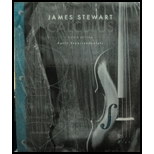
Calculus: Early Transcendentals, Loose-Leaf Version
8th Edition
ISBN: 9781305272354
Author: James Stewart
Publisher: Brooks Cole
expand_more
expand_more
format_list_bulleted
Concept explainers
Textbook Question
Chapter 17.3, Problem 1E
A spring has natural length 0.75 m and a 5-kg mass. A force of 25 N is needed to keep the spring stretched to a length of 1 m. If the spring is stretched to a length of 1.1 m and then released with velocity 0, find the position of the mass after t seconds.
Expert Solution & Answer
Trending nowThis is a popular solution!

Students have asked these similar questions
Can you answer this question and give step by step and why and how to get it. Can you write it (numerical method)
Can you answer this question and give step by step and why and how to get it. Can you write it (numerical method)
There are three options for investing $1150. The first earns 10% compounded annually, the second earns 10% compounded quarterly, and the third earns 10% compounded continuously. Find equations that model each investment growth and
use a graphing utility to graph each model in the same viewing window over a 20-year period. Use the graph to determine which investment yields the highest return after 20 years. What are the differences in earnings among the three
investment?
STEP 1: The formula for compound interest is
A =
nt
= P(1 + − − ) n²,
where n is the number of compoundings per year, t is the number of years, r is the interest rate, P is the principal, and A is the amount (balance) after t years. For continuous compounding, the formula reduces to
A = Pert
Find r and n for each model, and use these values to write A in terms of t for each case.
Annual Model
r=0.10
A = Y(t) = 1150 (1.10)*
n = 1
Quarterly Model
r = 0.10
n = 4
A = Q(t) = 1150(1.025) 4t
Continuous Model
r=0.10
A = C(t) =…
Chapter 17 Solutions
Calculus: Early Transcendentals, Loose-Leaf Version
Ch. 17.1 - Solve the differential equation. 1. y" y' 6y = 0Ch. 17.1 - Solve the differential equation. 2. y" 6y' + 9y =...Ch. 17.1 - Solve the differential equation. 3. y" + 2y = 0Ch. 17.1 - Solve the differential equation. 4. y" + y' 12y =...Ch. 17.1 - Solve the differential equation. 5. 4y" + 4y' + y...Ch. 17.1 - Solve the differential equation. 6. 9y" + 4y = 0Ch. 17.1 - Solve the differential equation. 7. 3y" = 4y'Ch. 17.1 - Prob. 8ECh. 17.1 - Solve the differential equation. 9. y" 4y' + 13y...Ch. 17.1 - Prob. 10E
Ch. 17.1 - Solve the differential equation. 11....Ch. 17.1 - Prob. 12ECh. 17.1 - Prob. 13ECh. 17.1 - Prob. 14ECh. 17.1 - Prob. 15ECh. 17.1 - Prob. 16ECh. 17.1 - Prob. 17ECh. 17.1 - Prob. 18ECh. 17.1 - Prob. 19ECh. 17.1 - Prob. 20ECh. 17.1 - Solve the initial-value problem. 21. y" 6y' + 10y...Ch. 17.1 - Solve the initial-value problem. 22. 4y" 20y' +...Ch. 17.1 - Prob. 23ECh. 17.1 - Solve the initial-value problem. 24. 4y" + 4y' +...Ch. 17.1 - Solve the boundary-value problem, if possible. 25....Ch. 17.1 - Prob. 26ECh. 17.1 - Prob. 27ECh. 17.1 - Prob. 28ECh. 17.1 - Solve the boundary-value problem, if possible. 29....Ch. 17.1 - Prob. 30ECh. 17.1 - Prob. 31ECh. 17.1 - Prob. 32ECh. 17.1 - Prob. 33ECh. 17.1 - If a, b, and c are all positive constants and y(x)...Ch. 17.2 - Solve the differential equation or initial-value...Ch. 17.2 - Prob. 2ECh. 17.2 - Prob. 3ECh. 17.2 - Solve the differential equation or initial-value...Ch. 17.2 - Prob. 5ECh. 17.2 - Prob. 6ECh. 17.2 - Prob. 7ECh. 17.2 - Prob. 8ECh. 17.2 - Solve the differential equation or initial-value...Ch. 17.2 - Prob. 10ECh. 17.2 - Prob. 11ECh. 17.2 - Prob. 12ECh. 17.2 - Write a trial solution for the method of...Ch. 17.2 - Prob. 14ECh. 17.2 - Prob. 15ECh. 17.2 - Prob. 16ECh. 17.2 - Prob. 17ECh. 17.2 - Write a trial solution for the method of...Ch. 17.2 - Solve the differential equation using (a)...Ch. 17.2 - Prob. 20ECh. 17.2 - Solve the differential equation using (a)...Ch. 17.2 - Prob. 22ECh. 17.2 - Prob. 23ECh. 17.2 - Solve the differential equation using the method...Ch. 17.2 - Prob. 25ECh. 17.2 - Solve the differential equation using the method...Ch. 17.2 - Solve the differential equation using the method...Ch. 17.2 - Solve the differential equation using the method...Ch. 17.3 - A spring has natural length 0.75 m and a 5-kg...Ch. 17.3 - A spring with an 8-kg mass is kept stretched 0.4 m...Ch. 17.3 - A spring with a mass of 2 kg has damping constant...Ch. 17.3 - Prob. 4ECh. 17.3 - For the spring in Exercise 3, find the mass that...Ch. 17.3 - Prob. 6ECh. 17.3 - Prob. 7ECh. 17.3 - Prob. 8ECh. 17.3 - Suppose a spring has mass m and spring constant k...Ch. 17.3 - As in Exercise 9, consider a spring with mass m,...Ch. 17.3 - Prob. 11ECh. 17.3 - Prob. 12ECh. 17.3 - A series circuit consists of a resistor with R =...Ch. 17.3 - A series circuit contains a resistor with R = 24 ,...Ch. 17.3 - The battery in Exercise 13 is replaced by a...Ch. 17.3 - Prob. 16ECh. 17.3 - Prob. 17ECh. 17.3 - The figure shows a pendulum with length I, and the...Ch. 17.4 - Use power series to solve the differential...Ch. 17.4 - Prob. 2ECh. 17.4 - Prob. 3ECh. 17.4 - Prob. 4ECh. 17.4 - Prob. 5ECh. 17.4 - Prob. 6ECh. 17.4 - Prob. 7ECh. 17.4 - Prob. 8ECh. 17.4 - Prob. 9ECh. 17.4 - Prob. 10ECh. 17.4 - Prob. 11ECh. 17.4 - The solution of the initial-value problem x2y" +...Ch. 17 - (a) Write the general form of a second-order...Ch. 17 - (a) What is an initial-value problem for a...Ch. 17 - (a) Write the general form of a second-order...Ch. 17 - Prob. 4RCCCh. 17 - Prob. 5RCCCh. 17 - Prob. 1RQCh. 17 - Prob. 2RQCh. 17 - Prob. 3RQCh. 17 - Prob. 4RQCh. 17 - Prob. 1RECh. 17 - Prob. 2RECh. 17 - Prob. 3RECh. 17 - Prob. 4RECh. 17 - Prob. 5RECh. 17 - Prob. 6RECh. 17 - Prob. 7RECh. 17 - Prob. 8RECh. 17 - Prob. 9RECh. 17 - Prob. 10RECh. 17 - Prob. 11RECh. 17 - Solve the initial-value problem. 12. y" 6y' + 25y...Ch. 17 - Prob. 13RECh. 17 - Solve the initial-value problem. 14. 9y" + y =3x +...Ch. 17 - Prob. 15RECh. 17 - Prob. 16RECh. 17 - Use power series to solve the initial-value...Ch. 17 - Use power series to solve differential equation y"...Ch. 17 - Prob. 19RECh. 17 - A spring with a mass of 2 kg has damping constant...Ch. 17 - Assume that the earth is a solid sphere of uniform...
Additional Math Textbook Solutions
Find more solutions based on key concepts
Students in a Listening Responses class bought 40 tickets for a piano concert. The number of tickets purchased ...
Elementary and Intermediate Algebra: Concepts and Applications (7th Edition)
Testing Hypotheses. In Exercises 13-24, assume that a simple random sample has been selected and test the given...
Elementary Statistics Using The Ti-83/84 Plus Calculator, Books A La Carte Edition (5th Edition)
Empirical versus Theoretical A Monopoly player claims that the probability of getting a 4 when rolling a six-si...
Introductory Statistics
Check Your Understanding
Reading Check Complete each sentence using > or < for □.
RC1. 3 dm □ 3 dam
Basic College Mathematics
(a) Make a stem-and-leaf plot for these 24 observations on the number of customers who used a down-town CitiBan...
APPLIED STAT.IN BUS.+ECONOMICS
Find E(X) for each of the distributions given in Exercise 2.1-3.
Probability And Statistical Inference (10th Edition)
Knowledge Booster
Learn more about
Need a deep-dive on the concept behind this application? Look no further. Learn more about this topic, calculus and related others by exploring similar questions and additional content below.Similar questions
- Use a graphing utility to find the point of intersection, if any, of the graphs of the functions. Round your result to three decimal places. (Enter NONE in any unused answer blanks.) y = 100e0.01x (x, y) = y = 11,250 ×arrow_forward5. For the function y-x³-3x²-1, use derivatives to: (a) determine the intervals of increase and decrease. (b) determine the local (relative) maxima and minima. (e) determine the intervals of concavity. (d) determine the points of inflection. (e) sketch the graph with the above information indicated on the graph.arrow_forwardCan you solve this 2 question numerical methodarrow_forward
- 1. Estimate the area under the graph of f(x)-25-x from x=0 to x=5 using 5 approximating rectangles Using: (A) right endpoints. (B) left endpoints.arrow_forward9. Use fundamental theorem of calculus to find the derivative d a) *dt sin(x) b)(x)√1-2 dtarrow_forward3. Evaluate the definite integral: a) √66x²+8dx b) x dx c) f*(2e* - 2)dx d) √√9-x² e) (2-5x)dx f) cos(x)dx 8)²₁₂√4-x2 h) f7dx i) f² 6xdx j) ²₂(4x+3)dxarrow_forward
- 2. Consider the integral √(2x+1)dx (a) Find the Riemann sum for this integral using right endpoints and n-4. (b) Find the Riemann sum for this same integral, using left endpoints and n=4arrow_forwardProblem 11 (a) A tank is discharging water through an orifice at a depth of T meter below the surface of the water whose area is A m². The following are the values of a for the corresponding values of A: A 1.257 1.390 x 1.50 1.65 1.520 1.650 1.809 1.962 2.123 2.295 2.462|2.650 1.80 1.95 2.10 2.25 2.40 2.55 2.70 2.85 Using the formula -3.0 (0.018)T = dx. calculate T, the time in seconds for the level of the water to drop from 3.0 m to 1.5 m above the orifice. (b) The velocity of a train which starts from rest is given by the fol- lowing table, the time being reckoned in minutes from the start and the speed in km/hour: | † (minutes) |2|4 6 8 10 12 14 16 18 20 v (km/hr) 16 28.8 40 46.4 51.2 32.0 17.6 8 3.2 0 Estimate approximately the total distance ran in 20 minutes.arrow_forwardX Solve numerically: = 0,95 In xarrow_forward
arrow_back_ios
SEE MORE QUESTIONS
arrow_forward_ios
Recommended textbooks for you
 Trigonometry (MindTap Course List)TrigonometryISBN:9781337278461Author:Ron LarsonPublisher:Cengage Learning
Trigonometry (MindTap Course List)TrigonometryISBN:9781337278461Author:Ron LarsonPublisher:Cengage Learning Linear Algebra: A Modern IntroductionAlgebraISBN:9781285463247Author:David PoolePublisher:Cengage Learning
Linear Algebra: A Modern IntroductionAlgebraISBN:9781285463247Author:David PoolePublisher:Cengage Learning Mathematics For Machine TechnologyAdvanced MathISBN:9781337798310Author:Peterson, John.Publisher:Cengage Learning,
Mathematics For Machine TechnologyAdvanced MathISBN:9781337798310Author:Peterson, John.Publisher:Cengage Learning, Algebra: Structure And Method, Book 1AlgebraISBN:9780395977224Author:Richard G. Brown, Mary P. Dolciani, Robert H. Sorgenfrey, William L. ColePublisher:McDougal Littell
Algebra: Structure And Method, Book 1AlgebraISBN:9780395977224Author:Richard G. Brown, Mary P. Dolciani, Robert H. Sorgenfrey, William L. ColePublisher:McDougal Littell Elementary Geometry for College StudentsGeometryISBN:9781285195698Author:Daniel C. Alexander, Geralyn M. KoeberleinPublisher:Cengage Learning
Elementary Geometry for College StudentsGeometryISBN:9781285195698Author:Daniel C. Alexander, Geralyn M. KoeberleinPublisher:Cengage Learning

Trigonometry (MindTap Course List)
Trigonometry
ISBN:9781337278461
Author:Ron Larson
Publisher:Cengage Learning

Linear Algebra: A Modern Introduction
Algebra
ISBN:9781285463247
Author:David Poole
Publisher:Cengage Learning

Mathematics For Machine Technology
Advanced Math
ISBN:9781337798310
Author:Peterson, John.
Publisher:Cengage Learning,

Algebra: Structure And Method, Book 1
Algebra
ISBN:9780395977224
Author:Richard G. Brown, Mary P. Dolciani, Robert H. Sorgenfrey, William L. Cole
Publisher:McDougal Littell

Elementary Geometry for College Students
Geometry
ISBN:9781285195698
Author:Daniel C. Alexander, Geralyn M. Koeberlein
Publisher:Cengage Learning
Area Between The Curve Problem No 1 - Applications Of Definite Integration - Diploma Maths II; Author: Ekeeda;https://www.youtube.com/watch?v=q3ZU0GnGaxA;License: Standard YouTube License, CC-BY